基础框架搭建
# 基础框架搭建
# 创建父工程
创建wogua-cloud
删除src文件夹
父工程主要做依赖版本的控制
pom文件添加依赖
<properties>
<easy-captcha.version>1.6.2</easy-captcha.version>
<java.version>1.8</java.version>
<hutool.version>5.8.0</hutool.version>
<spring-cloud-alibaba-version>2.1.1.RELEASE</spring-cloud-alibaba-version>
<spring-cloud.version>Hoxton.SR6</spring-cloud.version>
<mybatis-plus.version>3.5.1</mybatis-plus.version>
<p6spy.version>3.8.5</p6spy.version>
<fastjson.version>1.2.70</fastjson.version>
<dynamic-datasource.version>3.5.2</dynamic-datasource.version>
</properties>
<parent>
<groupId>org.springframework.boot</groupId>
<artifactId>spring-boot-starter-parent</artifactId>
<version>2.2.13.RELEASE</version>
<relativePath/>
</parent>
<dependencyManagement>
<dependencies>
<dependency>
<groupId>com.alibaba.cloud</groupId>
<artifactId>spring-cloud-alibaba-dependencies</artifactId>
<version>${spring-cloud-alibaba-version}</version>
<type>pom</type>
<scope>import</scope>
</dependency>
<dependency>
<groupId>org.springframework.cloud</groupId>
<artifactId>spring-cloud-dependencies</artifactId>
<version>${spring-cloud.version}</version>
<type>pom</type>
<scope>import</scope>
</dependency>
<!-- hutool工具包 -->
<dependency>
<groupId>cn.hutool</groupId>
<artifactId>hutool-all</artifactId>
<version>${hutool.version}</version>
</dependency>
<!-- mp -->
<dependency>
<groupId>com.baomidou</groupId>
<artifactId>mybatis-plus-boot-starter</artifactId>
<version>${mybatis-plus.version}</version>
</dependency>
<!-- 多数据源 -->
<dependency>
<groupId>com.baomidou</groupId>
<artifactId>dynamic-datasource-spring-boot-starter</artifactId>
<version>${dynamic-datasource.version}</version>
</dependency>
<!-- sql日志输出 -->
<dependency>
<groupId>p6spy</groupId>
<artifactId>p6spy</artifactId>
<version>${p6spy.version}</version>
</dependency>
<dependency>
<groupId>com.alibaba</groupId>
<artifactId>fastjson</artifactId>
<version>${fastjson.version}</version>
</dependency>
<!-- 验证码 -->
<dependency>
<groupId>com.github.whvcse</groupId>
<artifactId>easy-captcha</artifactId>
<version>${easy-captcha.version}</version>
</dependency>
</dependencies>
</dependencyManagement>
2
3
4
5
6
7
8
9
10
11
12
13
14
15
16
17
18
19
20
21
22
23
24
25
26
27
28
29
30
31
32
33
34
35
36
37
38
39
40
41
42
43
44
45
46
47
48
49
50
51
52
53
54
55
56
57
58
59
60
61
62
63
64
65
66
67
68
69
70
71
72
后续有用到的相关依赖直接引入,不需要加上版本
# common包介绍
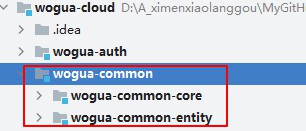
# 核心包介绍
wogua-common-core
wogua-common-core作为公共包的核心部分,主要是给各个服务提供基础支持,比如数据格式、状态码、参数校验、工具类等。
# 实体包介绍
wogua-common-entity
wogua-common-entity依赖于wogua-common-core,实体包主要是将微服务中额实体类、DT、VO等存放在一起,主要目的是便于微服务之间调用数据转换提供方便。仅仅出于此目的
# 启动器
因为从微服务的角度出发,各个服务中会用到相同中间件和功能,所以将上面所提到的现象抽取成一个个启动器,这里先介绍几个启动器,也是整个微服务中比较核心的启动器
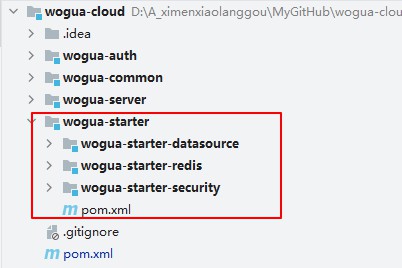
# 数据源启动器
各个服务中和数据库打交道是避免不了的,为了统一管理,这里也抽取成了启动器,命名为wogua-starter-datasource,相面具体介绍
pom依赖
<dependencies>
<dependency>
<groupId>com.baomidou</groupId>
<artifactId>mybatis-plus-boot-starter</artifactId>
</dependency>
<dependency>
<groupId>com.baomidou</groupId>
<artifactId>dynamic-datasource-spring-boot-starter</artifactId>
</dependency>
<dependency>
<groupId>p6spy</groupId>
<artifactId>p6spy</artifactId>
</dependency>
<dependency>
<groupId>mysql</groupId>
<artifactId>mysql-connector-java</artifactId>
<scope>runtime</scope>
</dependency>
</dependencies>
2
3
4
5
6
7
8
9
10
11
12
13
14
15
16
17
18
19
自动配置类
这里主要就是一个分页插件,后续会介绍数据权限相关问题 //TODO
@Configuration
public class WoguaDataSourceAutoConfigure {
/**
* 注册分页插件
*/
@Bean
@Order(-2)
public MybatisPlusInterceptor paginationInterceptor() {
MybatisPlusInterceptor interceptor = new MybatisPlusInterceptor();
// 分页插件
interceptor.addInnerInterceptor(new PaginationInnerInterceptor(DbType.MYSQL));
return interceptor;
}
}
2
3
4
5
6
7
8
9
10
11
12
13
14
15
16
spring.factories
在resource资源文件夹下创建spring.factories文件并填写人内容
# Auto Configure
org.springframework.boot.autoconfigure.EnableAutoConfiguration=\
center.helloworld.starter.datasource.configure.WoguaDataSourceAutoConfigure
2
3
将值替换成自己的自动配置类的全路径
# Redis启动器
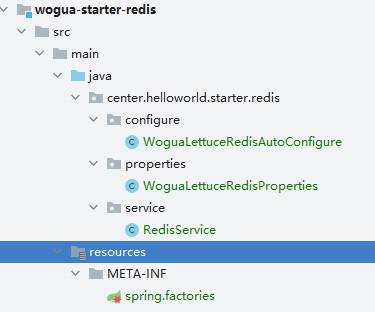
spring官方提供了redis相关的启动器,这里为什么还需要自己重新设计redis启动器呢,主要出于两个原因:
- redisTemplate的使用相对来说还是比较复杂,并且阅读起来也不是很方便,这里最终会设计成见名知意的方法
- 第二点就是解决java对象序列化的问题,具体请往下看,走你~~~
配置类
配置类主要是将配置信息封装成对象信息,在spring提供的启动器中、MySQL配置中等,都有用到
wogua-starter-redis配置类的启动器主要是控制我们自己编写的redis服务是否注入到spring容器中,供外界使用
具体如下:
@ConfigurationProperties(prefix = "wogua.lettuce.redis")
public class WoguaLettuceRedisProperties {
/**
* 是否开启Lettuce Redis
*/
private Boolean enable = true;
public Boolean getEnable() {
return enable;
}
public void setEnable(Boolean enable) {
this.enable = enable;
}
}
2
3
4
5
6
7
8
9
10
11
12
13
14
15
16
17
18
@ConfigurationProperties(prefix = "wogua.lettuce.redis")的作用就是将配置文件中wogua.lettuce.redis下的配置封装成WoguaLettuceRedisProperties对象,当然要想使其生效需要在添加上@component注解,但是这里为什么不需要呢?请继续往下看
服务类
RedisService服务类
主要是基于RedisTemplate再次封装,便于我们更友好的调用
package center.helloworld.starter.redis.service;
import org.slf4j.Logger;
import org.slf4j.LoggerFactory;
import org.springframework.beans.factory.annotation.Autowired;
import org.springframework.data.redis.core.RedisTemplate;
import java.util.Arrays;
import java.util.List;
import java.util.Map;
import java.util.Set;
import java.util.concurrent.TimeUnit;
public class RedisService {
private Logger log = LoggerFactory.getLogger(this.getClass());
@Autowired
private RedisTemplate<String, Object> redisTemplate;
/**
* 指定缓存失效时间
*
* @param key 键
* @param time 时间(秒)
* @return Boolean
*/
public Boolean expire(String key, Long time) {
try {
if (time > 0) {
redisTemplate.expire(key, time, TimeUnit.SECONDS);
}
return true;
} catch (Exception e) {
log.error(e.getMessage(), e);
return false;
}
}
/**
* 根据key获取过期时间
*
* @param key 键 不能为 null
* @return 时间(秒) 返回 0代表为永久有效
*/
public Long getExpire(String key) {
return redisTemplate.getExpire(key, TimeUnit.SECONDS);
}
/**
* 判断 key是否存在
*
* @param key 键
* @return true 存在 false不存在
*/
public Boolean hasKey(String key) {
try {
return redisTemplate.hasKey(key);
} catch (Exception e) {
log.error(e.getMessage(), e);
return false;
}
}
/**
* 删除缓存
*
* @param key 可以传一个值 或多个
*/
public void del(String... key) {
if (key != null && key.length > 0) {
if (key.length == 1) {
redisTemplate.delete(key[0]);
} else {
redisTemplate.delete(Arrays.asList(key));
}
}
}
/**
* 普通缓存获取
*
* @param key 键
* @return 值
*/
public Object get(String key) {
return key == null ? null : redisTemplate.opsForValue().get(key);
}
/**
* 普通缓存放入
*
* @param key 键
* @param value 值
* @return true成功 false失败
*/
public Boolean set(String key, Object value) {
try {
redisTemplate.opsForValue().set(key, value);
return true;
} catch (Exception e) {
log.error(e.getMessage(), e);
return false;
}
}
/**
* 普通缓存放入并设置时间
*
* @param key 键
* @param value 值
* @param time 时间(秒) time要大于0 如果time小于等于0 将设置无限期
* @return true成功 false 失败
*/
public Boolean set(String key, Object value, Long time) {
try {
if (time > 0) {
redisTemplate.opsForValue().set(key, value, time, TimeUnit.SECONDS);
} else {
set(key, value);
}
return true;
} catch (Exception e) {
log.error(e.getMessage(), e);
return false;
}
}
/**
* 递增
*
* @param key 键
* @param delta 要增加几(大于0)
* @return Long
*/
public Long incr(String key, Long delta) {
if (delta < 0) {
throw new RuntimeException("递增因子必须大于0");
}
return redisTemplate.opsForValue().increment(key, delta);
}
/**
* 递减
*
* @param key 键
* @param delta 要减少几
* @return Long
*/
public Long decr(String key, Long delta) {
if (delta < 0) {
throw new RuntimeException("递减因子必须大于0");
}
return redisTemplate.opsForValue().increment(key, -delta);
}
/**
* HashGet
*
* @param key 键 不能为 null
* @param item 项 不能为 null
* @return 值
*/
public Object hget(String key, String item) {
return redisTemplate.opsForHash().get(key, item);
}
/**
* 获取 hashKey对应的所有键值
*
* @param key 键
* @return 对应的多个键值
*/
public Map<Object, Object> hmget(String key) {
return redisTemplate.opsForHash().entries(key);
}
/**
* HashSet
*
* @param key 键
* @param map 对应多个键值
* @return true 成功 false 失败
*/
public Boolean hmset(String key, Map<String, Object> map) {
try {
redisTemplate.opsForHash().putAll(key, map);
return true;
} catch (Exception e) {
log.error(e.getMessage(), e);
return false;
}
}
/**
* HashSet 并设置时间
*
* @param key 键
* @param map 对应多个键值
* @param time 时间(秒)
* @return true成功 false失败
*/
public Boolean hmset(String key, Map<String, Object> map, Long time) {
try {
redisTemplate.opsForHash().putAll(key, map);
if (time > 0) {
expire(key, time);
}
return true;
} catch (Exception e) {
log.error(e.getMessage(), e);
return false;
}
}
/**
* 向一张hash表中放入数据,如果不存在将创建
*
* @param key 键
* @param item 项
* @param value 值
* @return true 成功 false失败
*/
public Boolean hset(String key, String item, Object value) {
try {
redisTemplate.opsForHash().put(key, item, value);
return true;
} catch (Exception e) {
log.error(e.getMessage(), e);
return false;
}
}
/**
* 向一张hash表中放入数据,如果不存在将创建
*
* @param key 键
* @param item 项
* @param value 值
* @param time 时间(秒) 注意:如果已存在的hash表有时间,这里将会替换原有的时间
* @return true 成功 false失败
*/
public Boolean hset(String key, String item, Object value, Long time) {
try {
redisTemplate.opsForHash().put(key, item, value);
if (time > 0) {
expire(key, time);
}
return true;
} catch (Exception e) {
log.error(e.getMessage(), e);
return false;
}
}
/**
* 删除hash表中的值
*
* @param key 键 不能为 null
* @param item 项 可以使多个不能为 null
*/
public void hdel(String key, Object... item) {
redisTemplate.opsForHash().delete(key, item);
}
/**
* 判断hash表中是否有该项的值
*
* @param key 键 不能为 null
* @param item 项 不能为 null
* @return true 存在 false不存在
*/
public Boolean hHasKey(String key, String item) {
return redisTemplate.opsForHash().hasKey(key, item);
}
/**
* hash递增 如果不存在,就会创建一个 并把新增后的值返回
*
* @param key 键
* @param item 项
* @param by 要增加几(大于0)
* @return Double
*/
public Double hincr(String key, String item, Double by) {
return redisTemplate.opsForHash().increment(key, item, by);
}
/**
* hash递减
*
* @param key 键
* @param item 项
* @param by 要减少记(小于0)
* @return Double
*/
public Double hdecr(String key, String item, Double by) {
return redisTemplate.opsForHash().increment(key, item, -by);
}
/**
* 根据 key获取 Set中的所有值
*
* @param key 键
* @return Set
*/
public Set<Object> sGet(String key) {
try {
return redisTemplate.opsForSet().members(key);
} catch (Exception e) {
log.error(e.getMessage(), e);
return null;
}
}
/**
* 根据value从一个set中查询,是否存在
*
* @param key 键
* @param value 值
* @return true 存在 false不存在
*/
public Boolean sHasKey(String key, Object value) {
try {
return redisTemplate.opsForSet().isMember(key, value);
} catch (Exception e) {
log.error(e.getMessage(), e);
return false;
}
}
/**
* 将数据放入set缓存
*
* @param key 键
* @param values 值 可以是多个
* @return 成功个数
*/
public Long sSet(String key, Object... values) {
try {
return redisTemplate.opsForSet().add(key, values);
} catch (Exception e) {
log.error(e.getMessage(), e);
return 0L;
}
}
/**
* 将set数据放入缓存
*
* @param key 键
* @param time 时间(秒)
* @param values 值 可以是多个
* @return 成功个数
*/
public Long sSetAndTime(String key, Long time, Object... values) {
try {
Long count = redisTemplate.opsForSet().add(key, values);
if (time > 0) {
expire(key, time);
}
return count;
} catch (Exception e) {
log.error(e.getMessage(), e);
return 0L;
}
}
/**
* 获取set缓存的长度
*
* @param key 键
* @return Long
*/
public Long sGetSetSize(String key) {
try {
return redisTemplate.opsForSet().size(key);
} catch (Exception e) {
log.error(e.getMessage(), e);
return 0L;
}
}
/**
* 移除值为value的
*
* @param key 键
* @param values 值 可以是多个
* @return 移除的个数
*/
public Long setRemove(String key, Object... values) {
try {
return redisTemplate.opsForSet().remove(key, values);
} catch (Exception e) {
log.error(e.getMessage(), e);
return 0L;
}
}
/**
* 获取list缓存的内容
*
* @param key 键
* @param start 开始
* @param end 结束 0 到 -1代表所有值
* @return List
*/
public List<Object> lGet(String key, Long start, Long end) {
try {
return redisTemplate.opsForList().range(key, start, end);
} catch (Exception e) {
log.error(e.getMessage(), e);
return null;
}
}
/**
* 获取list缓存的长度
*
* @param key 键
* @return Long
*/
public Long lGetListSize(String key) {
try {
return redisTemplate.opsForList().size(key);
} catch (Exception e) {
log.error(e.getMessage(), e);
return 0L;
}
}
/**
* 通过索引 获取list中的值
*
* @param key 键
* @param index 索引 index>=0时, 0 表头,1 第二个元素,依次类推;
* index<0时,-1,表尾,-2倒数第二个元素,依次类推
* @return Object
*/
public Object lGetIndex(String key, Long index) {
try {
return redisTemplate.opsForList().index(key, index);
} catch (Exception e) {
log.error(e.getMessage(), e);
return null;
}
}
/**
* 将list放入缓存
*
* @param key 键
* @param value 值
* @return Boolean
*/
public Boolean lSet(String key, Object value) {
try {
redisTemplate.opsForList().rightPush(key, value);
return true;
} catch (Exception e) {
log.error(e.getMessage(), e);
return false;
}
}
/**
* 将list放入缓存
*
* @param key 键
* @param value 值
* @param time 时间(秒)
* @return Boolean
*/
public Boolean lSet(String key, Object value, Long time) {
try {
redisTemplate.opsForList().rightPush(key, value);
if (time > 0) {
expire(key, time);
}
return true;
} catch (Exception e) {
log.error(e.getMessage(), e);
return false;
}
}
/**
* 将list放入缓存
*
* @param key 键
* @param value 值
* @return Boolean
*/
public Boolean lSet(String key, List<Object> value) {
try {
redisTemplate.opsForList().rightPushAll(key, value);
return true;
} catch (Exception e) {
log.error(e.getMessage(), e);
return false;
}
}
/**
* 将list放入缓存
*
* @param key 键
* @param value 值
* @param time 时间(秒)
* @return Boolean
*/
public Boolean lSet(String key, List<Object> value, Long time) {
try {
redisTemplate.opsForList().rightPushAll(key, value);
if (time > 0) {
expire(key, time);
}
return true;
} catch (Exception e) {
log.error(e.getMessage(), e);
return false;
}
}
/**
* 根据索引修改list中的某条数据
*
* @param key 键
* @param index 索引
* @param value 值
* @return Boolean
*/
public Boolean lUpdateIndex(String key, Long index, Object value) {
try {
redisTemplate.opsForList().set(key, index, value);
return true;
} catch (Exception e) {
log.error(e.getMessage(), e);
return false;
}
}
/**
* 移除N个值为value
*
* @param key 键
* @param count 移除多少个
* @param value 值
* @return 移除的个数
*/
public Long lRemove(String key, Long count, Object value) {
try {
return redisTemplate.opsForList().remove(key, count, value);
} catch (Exception e) {
log.error(e.getMessage(), e);
return 0L;
}
}
}
2
3
4
5
6
7
8
9
10
11
12
13
14
15
16
17
18
19
20
21
22
23
24
25
26
27
28
29
30
31
32
33
34
35
36
37
38
39
40
41
42
43
44
45
46
47
48
49
50
51
52
53
54
55
56
57
58
59
60
61
62
63
64
65
66
67
68
69
70
71
72
73
74
75
76
77
78
79
80
81
82
83
84
85
86
87
88
89
90
91
92
93
94
95
96
97
98
99
100
101
102
103
104
105
106
107
108
109
110
111
112
113
114
115
116
117
118
119
120
121
122
123
124
125
126
127
128
129
130
131
132
133
134
135
136
137
138
139
140
141
142
143
144
145
146
147
148
149
150
151
152
153
154
155
156
157
158
159
160
161
162
163
164
165
166
167
168
169
170
171
172
173
174
175
176
177
178
179
180
181
182
183
184
185
186
187
188
189
190
191
192
193
194
195
196
197
198
199
200
201
202
203
204
205
206
207
208
209
210
211
212
213
214
215
216
217
218
219
220
221
222
223
224
225
226
227
228
229
230
231
232
233
234
235
236
237
238
239
240
241
242
243
244
245
246
247
248
249
250
251
252
253
254
255
256
257
258
259
260
261
262
263
264
265
266
267
268
269
270
271
272
273
274
275
276
277
278
279
280
281
282
283
284
285
286
287
288
289
290
291
292
293
294
295
296
297
298
299
300
301
302
303
304
305
306
307
308
309
310
311
312
313
314
315
316
317
318
319
320
321
322
323
324
325
326
327
328
329
330
331
332
333
334
335
336
337
338
339
340
341
342
343
344
345
346
347
348
349
350
351
352
353
354
355
356
357
358
359
360
361
362
363
364
365
366
367
368
369
370
371
372
373
374
375
376
377
378
379
380
381
382
383
384
385
386
387
388
389
390
391
392
393
394
395
396
397
398
399
400
401
402
403
404
405
406
407
408
409
410
411
412
413
414
415
416
417
418
419
420
421
422
423
424
425
426
427
428
429
430
431
432
433
434
435
436
437
438
439
440
441
442
443
444
445
446
447
448
449
450
451
452
453
454
455
456
457
458
459
460
461
462
463
464
465
466
467
468
469
470
471
472
473
474
475
476
477
478
479
480
481
482
483
484
485
486
487
488
489
490
491
492
493
494
495
496
497
498
499
500
501
502
503
504
505
506
507
508
509
510
511
512
513
514
515
516
517
518
519
520
521
522
523
524
525
526
527
528
529
530
531
532
533
534
535
536
537
538
539
540
541
542
543
544
545
546
547
548
549
550
551
552
553
554
555
556
557
558
559
自动配置类
上面介绍了那么多,而且还留了相关悬念,这里将一一解答,我们先看一下自动配置类中有什么
@EnableConfigurationProperties(WoguaLettuceRedisProperties.class)
@ConditionalOnProperty(value = "wogua.lettuce.redis.enable", havingValue = "true", matchIfMissing = true)
public class WoguaLettuceRedisAutoConfigure {
@Bean(name = "redisTemplate")
@ConditionalOnClass(RedisOperations.class)
public RedisTemplate<String, Object> redisTemplate(RedisConnectionFactory factory) {
RedisTemplate<String, Object> template = new RedisTemplate<>();
template.setConnectionFactory(factory);
Jackson2JsonRedisSerializer<Object> jackson2JsonRedisSerializer = new Jackson2JsonRedisSerializer<>(Object.class);
ObjectMapper mapper = new ObjectMapper();
mapper.setVisibility(PropertyAccessor.ALL, JsonAutoDetect.Visibility.ANY);
mapper.activateDefaultTyping(mapper.getPolymorphicTypeValidator(), ObjectMapper.DefaultTyping.NON_FINAL);
jackson2JsonRedisSerializer.setObjectMapper(mapper);
StringRedisSerializer stringRedisSerializer = new StringRedisSerializer();
template.setKeySerializer(stringRedisSerializer);
template.setHashKeySerializer(stringRedisSerializer);
template.setValueSerializer(jackson2JsonRedisSerializer);
template.setHashValueSerializer(jackson2JsonRedisSerializer);
template.afterPropertiesSet();
return template;
}
@Bean
@ConditionalOnBean(name = "redisTemplate")
public RedisService redisService() {
return new RedisService();
}
}
2
3
4
5
6
7
8
9
10
11
12
13
14
15
16
17
18
19
20
21
22
23
24
25
26
27
28
29
30
31
32
很简单主要分为三块内容:
@EnableConfigurationProperties(WoguaLettuceRedisProperties.class)作用是:使使用 @ConfigurationProperties 注解的类生效。这里就解决了上面WoguaLettuceRedisProperties为什么不加@Component注解的原因- redisTemplate 方法主要用来解决java对象存储到redis中序列化问题
- 第三部分是将我们自己编写的redisService注入到容器中
spring.factories
和上面介绍的使用方法一样
# Auto Configure
org.springframework.boot.autoconfigure.EnableAutoConfiguration=\
center.helloworld.starter.redis.configure.WoguaLettuceRedisAutoConfigure
2
3
# 资源服务器启动器
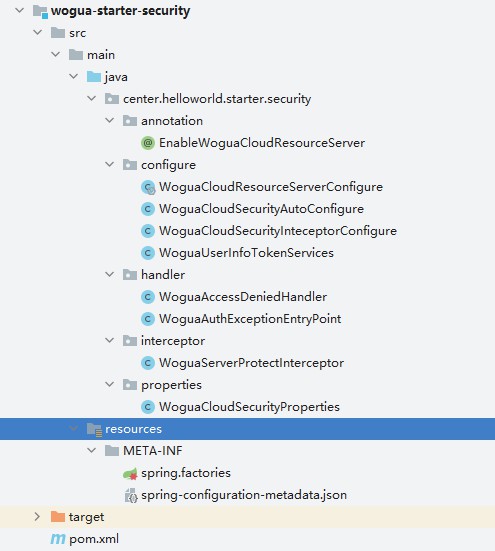
要想了解这块启动器,需要对 security和Oauth2.0协议有些了解!话不多说开干~~~
在OAuth2.0协议中主要和两部分核心组成,认证服务器和资源服务器,这里主要介绍的是资源服务器
由于可以将每个服务都看成一个资源服务器,所以这里将资源服务器的配置抽取成启动器
接下来,好好看,好好学~~
配置类
同样采用starter的标准写法,将可能需要改变的信息,转成配置,再封装成配置对象
@ConfigurationProperties(prefix = "wogua.cloud.security")
public class WoguaCloudSecurityProperties {
/**
* 是否开启安全配置
*/
private Boolean enable;
/**
* 配置需要认证的uri,默认为所有/**
*/
private String authUri = "/**";
/**
* 免认证资源路径,支持通配符
* 多个值时使用逗号分隔
*/
private String anonUris;
/**
* 是否只能通过网关获取资源
*/
private Boolean onlyFetchByGateway = Boolean.TRUE;
public Boolean getEnable() {
return enable;
}
public void setEnable(Boolean enable) {
this.enable = enable;
}
public String getAuthUri() {
return authUri;
}
public void setAuthUri(String authUri) {
this.authUri = authUri;
}
public String getAnonUris() {
return anonUris;
}
public void setAnonUris(String anonUris) {
this.anonUris = anonUris;
}
public Boolean getOnlyFetchByGateway() {
return onlyFetchByGateway;
}
public void setOnlyFetchByGateway(Boolean onlyFetchByGateway) {
this.onlyFetchByGateway = onlyFetchByGateway;
}
}
2
3
4
5
6
7
8
9
10
11
12
13
14
15
16
17
18
19
20
21
22
23
24
25
26
27
28
29
30
31
32
33
34
35
36
37
38
39
40
41
42
43
44
45
46
47
48
49
50
51
52
53
enable:表示是否开启配置authUri:由于是资源服务器,是需要对外提供相应的服务接口,对于需要认证的接口进行拦截,这里默认是/**,但是也可以在配置文件中进行自行配置,这样就会覆盖当前的默认配置/**anonUris:有些资源是无需登录就可访问的,这里代表免认证资源路径,支持通配符, 多个值时使用逗号分隔onlyFetchByGateway属性,判断是否要求网关转发,后面以后详细介绍
异常处理器 handler
资源服务的访问异常大体分为两种:
- 认证异常,说白了没登录就来访问
- 权限异常,你没有相关接口的访问权限
WoguaAuthExceptionEntryPoint
认证异常信息
public class WoguaAuthExceptionEntryPoint implements AuthenticationEntryPoint {
@Override
public void commence(HttpServletRequest httpServletRequest, HttpServletResponse response, AuthenticationException e) throws IOException, ServletException {
Result result = new Result();
result.setFlag(false);
result.setCode(AuthExceptionCode.ERROR_INVALID_TOKEN.getCode());
result.setMsg(AuthExceptionCode.ERROR_INVALID_TOKEN.getMessage());
ResponseUtil.makeResponse(response, MediaType.APPLICATION_JSON_UTF8_VALUE, HttpServletResponse.SC_UNAUTHORIZED, result);
}
}
2
3
4
5
6
7
8
9
10
11
WoguaAccessDeniedHandler
权限异常信息
public class WoguaAccessDeniedHandler implements AccessDeniedHandler {
@Override
public void handle(HttpServletRequest httpServletRequest, HttpServletResponse response, AccessDeniedException e) throws IOException, ServletException {
Result result = new Result();
result.setFlag(AuthExceptionCode.ERROR_NO_PERMISSION.isFlag());
result.setCode(AuthExceptionCode.ERROR_NO_PERMISSION.getCode());
result.setMsg(AuthExceptionCode.ERROR_NO_PERMISSION.getMessage());
ResponseUtil.makeResponse(
response, MediaType.APPLICATION_JSON_UTF8_VALUE,
HttpServletResponse.SC_FORBIDDEN, result);
}
}
2
3
4
5
6
7
8
9
10
11
12
看到这,大家会有个问题,AuthExceptionCode是什么,这是一个枚举类,封装了,一些状态和信息,具体的可以砍源码
路由拦截器
这里额外做了个小功能,拦截器,主要用来判断用户请求是否是网关转发过来的,要不是的话会抛出异常,当然这是可以配置的,具体如下
public class WoguaServerProtectInterceptor implements HandlerInterceptor {
private WoguaCloudSecurityProperties properties;
@Override
public boolean preHandle(@NonNull HttpServletRequest request, @NonNull HttpServletResponse response, @NonNull Object handler) throws IOException {
if (!properties.getOnlyFetchByGateway()) {
return true;
}
String token = request.getHeader(WoguaConstant.GATEWAY_TOKEN_HEADER);
String gatewayToken = new String(Base64Utils.encode(WoguaConstant.GATEWAY_TOKEN_VALUE.getBytes()));
if (StringUtils.equals(gatewayToken, token)) {
return true;
} else {
Result result = new Result();
result.setFlag(false);
result.setCode(0);
result.setMsg("请通过网关获取资源");
ResponseUtil.makeResponse(response, MediaType.APPLICATION_JSON_VALUE,HttpServletResponse.SC_FORBIDDEN,result);
return false;
}
}
public void setProperties(WoguaCloudSecurityProperties properties) {
this.properties = properties;
}
}
2
3
4
5
6
7
8
9
10
11
12
13
14
15
16
17
18
19
20
21
22
23
24
25
26
27
配置文件中会有onlyFetchByGateway属性,判断是否要求网关转发
自动配置类
@EnableResourceServer
@EnableAutoConfiguration(exclude = UserDetailsServiceAutoConfiguration.class)
public class WoguaCloudResourceServerConfigure extends ResourceServerConfigurerAdapter {
private WoguaCloudSecurityProperties properties;
private WoguaAccessDeniedHandler accessDeniedHandler;
private WoguaAuthExceptionEntryPoint exceptionEntryPoint;
@Autowired(required = false)
public void setProperties(WoguaCloudSecurityProperties properties) {
this.properties = properties;
}
@Autowired(required = false)
public void setAccessDeniedHandler(WoguaAccessDeniedHandler accessDeniedHandler) {
this.accessDeniedHandler = accessDeniedHandler;
}
@Autowired(required = false)
public void setExceptionEntryPoint(WoguaAuthExceptionEntryPoint exceptionEntryPoint) {
this.exceptionEntryPoint = exceptionEntryPoint;
}
@Override
public void configure(HttpSecurity http) throws Exception {
if (properties == null) {
permitAll(http);
return;
}
String[] anonUrls = StringUtils.splitByWholeSeparatorPreserveAllTokens(properties.getAnonUris(), ",");
if (ArrayUtils.isEmpty(anonUrls)) {
anonUrls = new String[]{};
}
if (ArrayUtils.contains(anonUrls, "/**")) {
permitAll(http);
return;
}
http.csrf().disable()
.requestMatchers().antMatchers(properties.getAuthUri())
.and()
.authorizeRequests()
.antMatchers(anonUrls).permitAll()
.antMatchers(properties.getAuthUri()).authenticated()
.and()
.httpBasic();
}
@Override
public void configure(ResourceServerSecurityConfigurer resources) {
if (exceptionEntryPoint != null) {
resources.authenticationEntryPoint(exceptionEntryPoint);
}
if (accessDeniedHandler != null) {
resources.accessDeniedHandler(accessDeniedHandler);
}
}
private void permitAll(HttpSecurity http) throws Exception {
http.csrf().disable();
http.authorizeRequests().anyRequest().permitAll();
}
}
2
3
4
5
6
7
8
9
10
11
12
13
14
15
16
17
18
19
20
21
22
23
24
25
26
27
28
29
30
31
32
33
34
35
36
37
38
39
40
41
42
43
44
45
46
47
48
49
50
51
52
53
54
55
56
57
58
59
60
61
62
63
WoguaCloudSecurityInteceptorConfigure类就是将拦截器生效
令牌服务
资源服务器拿到令牌后,如何证明这令牌是合法的呢?
因此针对这种情况会有很多方法,同时也包括自定义方法,1. 携带令牌访问认证服务,让他做决定。2. 自己判断,比如jwt,需要有相关的秘钥信息,3. 自定义判断是否有效。在资源服务器配置中详细介绍
资源服务器配置
@EnableResourceServer
@EnableAutoConfiguration(exclude = UserDetailsServiceAutoConfiguration.class)
public class WoguaCloudResourceServerConfigure extends ResourceServerConfigurerAdapter {
private WoguaCloudSecurityProperties properties;
private WoguaAccessDeniedHandler accessDeniedHandler;
private WoguaAuthExceptionEntryPoint exceptionEntryPoint;
@Autowired(required = false)
public void setProperties(WoguaCloudSecurityProperties properties) {
this.properties = properties;
}
@Autowired(required = false)
public void setAccessDeniedHandler(WoguaAccessDeniedHandler accessDeniedHandler) {
this.accessDeniedHandler = accessDeniedHandler;
}
@Autowired(required = false)
public void setExceptionEntryPoint(WoguaAuthExceptionEntryPoint exceptionEntryPoint) {
this.exceptionEntryPoint = exceptionEntryPoint;
}
@Override
public void configure(HttpSecurity http) throws Exception {
if (properties == null) {
permitAll(http);
return;
}
String[] anonUrls = StringUtils.splitByWholeSeparatorPreserveAllTokens(properties.getAnonUris(), ",");
if (ArrayUtils.isEmpty(anonUrls)) {
anonUrls = new String[]{};
}
if (ArrayUtils.contains(anonUrls, "/**")) {
permitAll(http);
return;
}
http.csrf().disable()
.requestMatchers().antMatchers(properties.getAuthUri())
.and()
.authorizeRequests()
.antMatchers(anonUrls).permitAll()
.antMatchers(properties.getAuthUri()).authenticated()
.and()
.httpBasic();
}
@Override
public void configure(ResourceServerSecurityConfigurer resources) {
if (exceptionEntryPoint != null) {
resources.authenticationEntryPoint(exceptionEntryPoint);
}
if (accessDeniedHandler != null) {
resources.accessDeniedHandler(accessDeniedHandler);
}
}
private void permitAll(HttpSecurity http) throws Exception {
http.csrf().disable();
http.authorizeRequests().anyRequest().permitAll();
}
}
2
3
4
5
6
7
8
9
10
11
12
13
14
15
16
17
18
19
20
21
22
23
24
25
26
27
28
29
30
31
32
33
34
35
36
37
38
39
40
41
42
43
44
45
46
47
48
49
50
51
52
53
54
55
56
57
58
59
60
61
62
63
- configure(HttpSecurity http)方法中,主要配置拦截放行路径,结合配置类可以方便的调整
- configure(ResourceServerSecurityConfigurer resources) 资源服务器安全配置
自动配置类
@EnableGlobalMethodSecurity(prePostEnabled = true)
@EnableConfigurationProperties(WoguaCloudSecurityProperties.class)
@ConditionalOnProperty(value = "wogua.cloud.security.enable", havingValue = "true", matchIfMissing = true)
public class WoguaCloudSecurityAutoConfigure extends GlobalMethodSecurityConfiguration {
@Bean
@ConditionalOnMissingBean(name = "accessDeniedHandler")
public WoguaAccessDeniedHandler accessDeniedHandler() {
return new WoguaAccessDeniedHandler();
}
@Bean
@ConditionalOnMissingBean(name = "authenticationEntryPoint")
public WoguaAuthExceptionEntryPoint authenticationEntryPoint() {
return new WoguaAuthExceptionEntryPoint();
}
@Bean
@ConditionalOnMissingBean(value = PasswordEncoder.class)
public PasswordEncoder passwordEncoder() {
return new BCryptPasswordEncoder();
}
@Bean
public WoguaCloudSecurityInteceptorConfigure woguaCloudSecurityInteceptorConfigure() {
return new WoguaCloudSecurityInteceptorConfigure();
}
@Bean
@Primary
@ConditionalOnMissingBean(DefaultTokenServices.class)
public WoguaUserInfoTokenServices febsUserInfoTokenServices(ResourceServerProperties properties) {
return new WoguaUserInfoTokenServices(properties.getUserInfoUri(), properties.getClientId());
}
/**
* feign远程调用拦截器,请求头携带认证信息
* @return
*/
@Bean
public RequestInterceptor oauth2FeignRequestInterceptor() {
return requestTemplate -> {
String gatewayToken = new String(Base64Utils.encode(WoguaConstant.GATEWAY_TOKEN_VALUE.getBytes()));
requestTemplate.header(WoguaConstant.GATEWAY_TOKEN_HEADER, gatewayToken);
String authorizationToken = getCurrentTokenValue();
if (StringUtils.isNotBlank(authorizationToken)) {
requestTemplate.header(HttpHeaders.AUTHORIZATION, WoguaConstant.OAUTH2_TOKEN_TYPE + authorizationToken);
}
};
}
/**
* 获取当前令牌内容
*
* @return String 令牌内容
*/
public String getCurrentTokenValue() {
try {
OAuth2AuthenticationDetails details = (OAuth2AuthenticationDetails) getOauth2Authentication().getDetails();
return details.getTokenValue();
} catch (Exception ignore) {
return null;
}
}
private OAuth2Authentication getOauth2Authentication() {
Authentication authentication = SecurityContextHolder.getContext().getAuthentication();
return (OAuth2Authentication) authentication;
}
@Override
protected MethodSecurityExpressionHandler createExpressionHandler() {
return new OAuth2MethodSecurityExpressionHandler();
}
}
2
3
4
5
6
7
8
9
10
11
12
13
14
15
16
17
18
19
20
21
22
23
24
25
26
27
28
29
30
31
32
33
34
35
36
37
38
39
40
41
42
43
44
45
46
47
48
49
50
51
52
53
54
55
56
57
58
59
60
61
62
63
64
65
66
67
68
69
70
71
72
73
74
75
- 拦截器配置
- token服务配置
- feign请求拦截器,用来配置请求头信息
# 认证服务器
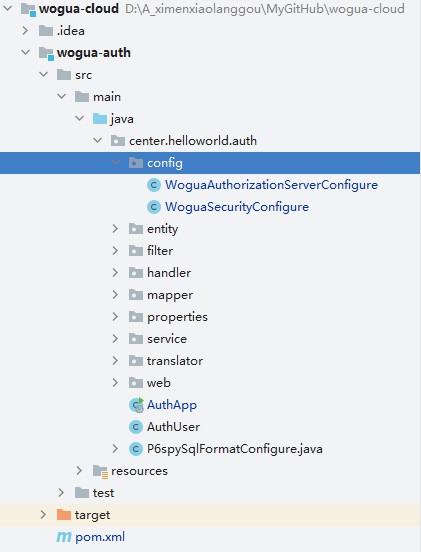
WoguaSecurityConfigure
安全配置适配器
/**
* 认证管理器
* Tip: 因为密码模式需要使用到这个Bean
* 当然,你可以自己实现PasswordEncoder接口,这里为了方便就直接使用BCryptPasswordEncoder了
* @return
* @throws Exception
*/
@Bean
@Override
public AuthenticationManager authenticationManagerBean() throws Exception {
return super.authenticationManagerBean();
}
@Override
protected void configure(HttpSecurity http) throws Exception {
http.addFilterBefore(validateCodeFilter, UsernamePasswordAuthenticationFilter.class)
.requestMatchers()
.antMatchers("/oauth/**","/login")
.and()
.authorizeRequests()
.antMatchers("/oauth/**").authenticated()
.and()
.formLogin()
.loginPage("/login")
.loginProcessingUrl("/login")
.successHandler(successHandler)
.failureHandler(failureHandler)
.permitAll()
.and().csrf().disable()
.httpBasic().disable();
}
@Override
protected void configure(AuthenticationManagerBuilder auth) throws Exception {
auth.userDetailsService(userDetailService).passwordEncoder(passwordEncoder);
}
}
2
3
4
5
6
7
8
9
10
11
12
13
14
15
16
17
18
19
20
21
22
23
24
25
26
27
28
29
30
31
32
33
34
35
36
37
- 路径安全配置,哪些放行哪些需要认证
- 自定义userDetailService,用于实现登录逻辑
注意到validateCodeFilter用来做验证码登
@Slf4j
@Component
@RequiredArgsConstructor
public class ValidateCodeFilter extends OncePerRequestFilter {
private final ValidateCodeService validateCodeService;
@Override
protected void doFilterInternal(@Nonnull HttpServletRequest httpServletRequest, @Nonnull HttpServletResponse httpServletResponse,
@Nonnull FilterChain filterChain) throws ServletException, IOException {
String header = httpServletRequest.getHeader(HttpHeaders.AUTHORIZATION);
RequestMatcher matcher = new AntPathRequestMatcher("/oauth/token", HttpMethod.POST.toString());
if (matcher.matches(httpServletRequest)
&& StringUtils.equalsIgnoreCase(httpServletRequest.getParameter("grant_type"), "password")) {
try {
validateCode(httpServletRequest);
filterChain.doFilter(httpServletRequest, httpServletResponse);
} catch (Exception e) {
Map map = new LinkedHashMap();
map.put("flag",false);
map.put("message",e.getMessage());
ResponseUtil.makeResponse(httpServletResponse, MediaType.APPLICATION_JSON_VALUE, HttpServletResponse.SC_INTERNAL_SERVER_ERROR, map);
log.error(e.getMessage(), e);
}
} else {
filterChain.doFilter(httpServletRequest, httpServletResponse);
}
}
private void validateCode(HttpServletRequest httpServletRequest) throws Exception {
String code = httpServletRequest.getParameter("code");
String key = httpServletRequest.getParameter("key");
validateCodeService.check(key, code);
}
}
2
3
4
5
6
7
8
9
10
11
12
13
14
15
16
17
18
19
20
21
22
23
24
25
26
27
28
29
30
31
32
33
34
35
36
认证服务器配置
@Configuration
@EnableAuthorizationServer
@RequiredArgsConstructor
public class WoguaAuthorizationServerConfigure extends AuthorizationServerConfigurerAdapter {
private final PasswordEncoder passwordEncoder;
private final AuthenticationManager authenticationManager;
private WoguaUserDetailService userDetailService;
private RedisConnectionFactory redisConnectionFactory;
private final WoguaWebResponseExceptionTranslator exceptionTranslator;
private final WoguaAuthProperties authProperties;
private final RedisClientDetailsService redisClientDetailsService;
private DataSource dataSource;
/**
* 客户端配置
* @param clients
* @throws Exception
*/
@Override
public void configure(ClientDetailsServiceConfigurer clients) throws Exception {
// RedisClientDetailsService 集成自JDBC实现MySQL和Redis双存储
clients.withClientDetails(redisClientDetailsService);
}
/**
* 站点配置
* @param endpoints
*/
@Override
public void configure(AuthorizationServerEndpointsConfigurer endpoints) {
endpoints.tokenStore(tokenStore())
.userDetailsService(userDetailService)
.authenticationManager(authenticationManager)
.exceptionTranslator(exceptionTranslator) // 异常翻译实现自定义异常
.tokenServices(defaultTokenServices());
}
@Bean
public TokenStore tokenStore() {
if (authProperties.getEnableJwt()) {
return new JwtTokenStore(jwtAccessTokenConverter());
} else {
RedisTokenStore redisTokenStore = new RedisTokenStore(redisConnectionFactory);
// 解决每次生成的 token都一样的问题
redisTokenStore.setAuthenticationKeyGenerator(oAuth2Authentication -> UUID.randomUUID().toString());
return redisTokenStore;
}
}
@Bean
public JwtAccessTokenConverter jwtAccessTokenConverter() {
JwtAccessTokenConverter accessTokenConverter = new JwtAccessTokenConverter();
DefaultAccessTokenConverter defaultAccessTokenConverter = (DefaultAccessTokenConverter) accessTokenConverter.getAccessTokenConverter();
DefaultUserAuthenticationConverter userAuthenticationConverter = new DefaultUserAuthenticationConverter();
userAuthenticationConverter.setUserDetailsService(userDetailService);
defaultAccessTokenConverter.setUserTokenConverter(userAuthenticationConverter);
accessTokenConverter.setSigningKey(authProperties.getJwtAccessKey());
return accessTokenConverter;
}
@Primary
@Bean
public DefaultTokenServices defaultTokenServices() {
DefaultTokenServices tokenServices = new DefaultTokenServices();
tokenServices.setTokenStore(tokenStore());
tokenServices.setSupportRefreshToken(true);
tokenServices.setClientDetailsService(redisClientDetailsService);
return tokenServices;
}
@Bean
public ResourceOwnerPasswordTokenGranter resourceOwnerPasswordTokenGranter(AuthenticationManager authenticationManager, OAuth2RequestFactory oAuth2RequestFactory) {
DefaultTokenServices defaultTokenServices = defaultTokenServices();
if (authProperties.getEnableJwt()) {
defaultTokenServices.setTokenEnhancer(jwtAccessTokenConverter());
}
return new ResourceOwnerPasswordTokenGranter(authenticationManager, defaultTokenServices, redisClientDetailsService, oAuth2RequestFactory);
}
@Bean
public DefaultOAuth2RequestFactory oAuth2RequestFactory() {
return new DefaultOAuth2RequestFactory(redisClientDetailsService);
}
}
2
3
4
5
6
7
8
9
10
11
12
13
14
15
16
17
18
19
20
21
22
23
24
25
26
27
28
29
30
31
32
33
34
35
36
37
38
39
40
41
42
43
44
45
46
47
48
49
50
51
52
53
54
55
56
57
58
59
60
61
62
63
64
65
66
67
68
69
70
71
72
73
74
75
76
77
78
79
80
81
82
83
84
85
86
87
88
89
90
91
92
public void configure(ClientDetailsServiceConfigurer clients)
主要配置的是客户端,客户端存储方式等
@Slf4j
@Service
public class RedisClientDetailsService extends JdbcClientDetailsService {}
2
3
这里是自定义了RedisClientDetailsService并实现了默认的JdbcClientDetailsService存储方式
目的在于利用缓存提高效率
public void configure(AuthorizationServerEndpointsConfigurer endpoints)
该重写方法为站点配置
public void configure(AuthorizationServerEndpointsConfigurer endpoints) {
endpoints.tokenStore(tokenStore())
.userDetailsService(userDetailService)
.authorizationCodeServices(authenticationCodeService)
.authenticationManager(authenticationManager)
.exceptionTranslator(exceptionTranslator);
if (authProperties.getEnableJwt()) {
endpoints.accessTokenConverter(jwtAccessTokenConverter());
}
}
2
3
4
5
6
7
8
9
10
主要包含:
- 令牌存储方式
- 认证管理器
- 用户详情(用户登录查询一般)
- exceptionTranslator,异常翻译
- 如果设置jwt就需要设置token转换规则
